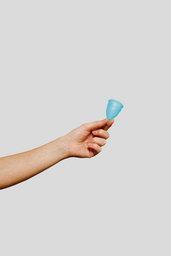I would like to start off by saying that making the change to the menstrual cup is a big decision, and one that I had been considering for years before finally committing to in January 2020. The thing that pushed me over the edge was actually a recommendation from a friend and fellow Planned Parenthood intern. My hope is that if you, dear reader, are debating over making the switch like I was, this article of personal testimony and fun facts makes your decision just a little bit easier.
The menstrual cup has some obvious positive features, but to me the two biggest draws were lessening my environmental impact and saving money. Menstrual cups should be replaced yearly, but even with one new cup every year you will be saving both the environmental and the financial cost of approximately 240 tampons! The average woman spends approximately $300/year just on tampons, and we all know that most of us also spend money on overnight pads, panty liners, and all the other sanitary products it takes to minimize the effects of period odor and leakage.
Because all menstrual cups should be made of medical-grade silicone (always check if you’re buying discounted brands online!), they can safely be worn for up to 12 hours, minimizing both leaks and risk of Toxic Shock Syndrome (TSS). Regular pads and tampons often contain unwanted chemicals such as pesticides, fragrances, and bleach that can affect your vagina’s natural pH, increasing odors as well as the chance of negative reactions (i.e., infections, allergic reactions, and TSS) when worn for long periods of time. The cup can easily be worn for one sleep, eliminating the fear of overnight leaks and other negative features of mainstream disposable products. Also, if like me one of your fears was having to clean it in a public bathroom, no need to worry! 12-hour wear means you can go the whole school day without worrying about cleaning the cup!
If I haven’t convinced you yet, the cup is also incredibly easy to take care of. You’ll want to clean it with soap and warm water each time you take it out. It’s incredibly important to use an unscented, mild, natural soap when cleaning it to help your vagina out and avoid yeast infections. I use Dr. Bronner’s Pure Castile Soap (unscented baby). This soap is easy to find at your local health food store such as Down to Earth; some stores that sell in bulk allow you to bring in and refill your own reusable container. You should also boil the cup for ten minutes at the end of your period each month to ensure it stays clean. Please note that if you are using a clear cup stains are normal and do not mean that your cup is dirty.
Here’s some fast facts/tips/suggestions that I learned the hard way to save you time!
- Insert the cup while standing- insertion can be challenging the first few times, but most cups come with insertion instructions to help you out. I find the best way is to stand with one foot on toilet for the best angle, then just fold the cup as indicated in your instructions, reach in and wiggle it around a bit until it pops into place, and you’re golden!
- Keep calm when you remove it the first few times- the packaging should give you instructions for this bit, but it can be shocking the first few times as it comes out suddenly. Make sure to do this step over the toilet on heavy days to avoid a mess.
- You CAN wear the cup if you’re just spotting- unlike tampons, it does not hurt to remove the cup on drier days because the silicone doesn’t absorb anything, meaning your natural lubrication is still there to help you out!
- I recommend getting reusable period panties too- although the cup reduces leakage, it’s not always perfect, particularly when you’re just starting out. Cups that aren’t inserted perfectly don’t have suction which is when you’ll get leaks. Making the transition to the cup is all about making yourself feel comfortable, and I feel at my best with an extra layer of protection from my Ruby period panties. Period panties wash up well and do not need to be replaced annually like cups.
By now I’m sure I’ve convinced you to give the cup a try, so the last question I have to answer is: What should I do with all those pads/tampons I don’t need anymore? Firstly, I would encourage you to hold onto them for the first month to make sure the cup is the right fit for you (literally). Cups come in different sizes so do research beforehand to make sure the cup you’ve picked is the right one for you before dropping $40 on one. Once you’re sure the cup is what makes you feel your best, I recommend putting a few of your old pads and tampons in your purse/backpack/suitcases for emergencies, then donating the rest! Unfortunately, period products are considered luxury items and because of their high cost many people live with period poverty every day. Contact local charities such as Ma’i Period Movement and I Support the Girls Hawaii on social media for more information on how to donate, the work they do, and what you can do to support!
I hope this article has given you the confidence to make a big change to help the environment, your pocketbook, and most importantly, your community.


